ALPHABET, THE HEBREW:
By: Mark Lidzbarsky
- Origin of Alphabet.
- Moabite Stone.
- Seals.
- Coins.
- Samaritan Alphabet.
- Aramaic Origin of Modern Hebrew Letters.
- Changes in Letters.
- Causes of Adoption of Aramaic.
- The 'AraḲ-el-Emir Inscription.
- Stone-Chest Inscriptions.
- Final Letters.
- Changes in Letters.
- Inscriptions in Square Characters.
- Ornamentation of Letters.
- Names for Hebrew Script.
- Influence of Ligature.
- Influence of Writing Material.
- Local Variations of Script.
- The "Ketibah Tammah."
- Transliteration of Foreign Languages.
- Cursive Script.
- "Rashi" Script.
- Plate I.
- (Old Hebrew and Samaritan.)
- Plate II.
- (Origin and Development of the Hebrew Square Alphabet.)
- Plate III.
- (Ancient Hebrew Inscriptions.)
- Plate IV.
- (Manuscript Writing.)
- Plate V.
- (Cursive Writing.)
The characters of the Hebrew Alphabet are derived from the so-called Phenician or Old Semitic letters, to which almost all systems of letters now in use, even the Roman, can be traced. But this latter is in mediate relation only to the original source, while the Hebrew Alphabet has kept closer to the primitive signs. In spite of the great progress made in Semitic paleography during the last decades, which enables the student to follow, step by step, the several styles of characters used by the various Semitic peoples from the ninth century  is manifestly an expansion of
is manifestly an expansion of  ) is merely x (ח), enclosed in a circle; again by the addition of a horizontal line between the top and bottom strokes
) is merely x (ח), enclosed in a circle; again by the addition of a horizontal line between the top and bottom strokes  ) is formed from
) is formed from  , and a perpendicular stroke served perhaps to develop
, and a perpendicular stroke served perhaps to develop  ) from W (ש). Though it may be impossible to determine with certainty of what race the inventor of these letters was, the alphabet undoubtedly received these expansions from a Semite. If it be conceded that the names of the letters of the alphabet originated with the same man, then, since their form is Aramaic, one could say that he was an Aramean; but they may also have arisen somewhat later. The names for the characters were chosen with reference to near-by things, such as parts of the body and other objects of the daily life peculiar to the Bedouins, the name of each of which began with the very sound the letter indicated. In a few cases the names seem to have been derived from the form which the sign represented. These names, as well as the order of the letters, certainly existed at least one thousand years
) from W (ש). Though it may be impossible to determine with certainty of what race the inventor of these letters was, the alphabet undoubtedly received these expansions from a Semite. If it be conceded that the names of the letters of the alphabet originated with the same man, then, since their form is Aramaic, one could say that he was an Aramean; but they may also have arisen somewhat later. The names for the characters were chosen with reference to near-by things, such as parts of the body and other objects of the daily life peculiar to the Bedouins, the name of each of which began with the very sound the letter indicated. In a few cases the names seem to have been derived from the form which the sign represented. These names, as well as the order of the letters, certainly existed at least one thousand years
The most important monument written in alphabetical characters of this epoch comes from a territory closely bordering on Palestine. Not only does the language of this section greatly resemble the Hebrew, but the writing already exhibits a coloring which approaches the epigraphic monuments of Palestine. This is the famous Moabite stone, which was discovered in 1868 by the Alsatian missionary Klein near Dibon in the land of Moab. Various governments attempted to obtain possession of this valuable stone; and when Turkey began to participate in the strife, the Bedouins, from intense hatred of the Turks, broke it into bits. The greater part of the fragments were, however, recovered and placed in the Museum of the Louvre in Paris. This monument dates from Mesha, king of Moab, mentioned in II Kings, iii. 4, who describes upon it his victorious wars against Israel and his doings in the interior of his land. The language, with slight deviations, is Hebrew, and reads almost like a chapter from the Book of Kings. The form of the letters is already essentially cursive. One peculiarity which the inscriptions on this monument have in common with Hebrew, and which the latter idiom has developed still further, is of special interest; namely, the tendency to bend the stems of the letters which slant to the left, so as to bring them nearer to the letter that follows, and also to extend the letters more in the width than in their length or perpendicular dimension. These are ṭhe eight lines of the inscription transliterated into the later Hebrew characters, according to Lidzbarski's "Handbuch," Plate I. See Moabite Stone, and Bibliography 3.
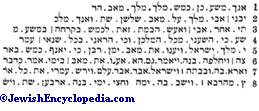
Palestinian monuments of the earliest antiquity are very rare. From the preexilic time there exists butone inscription of any length, found in the Siloam tunnel in 1881. It relates an episode from the construction of the conduit, and dates perhaps from the time of Hezekiah. The six lines below transliterated are taken from a photograph in the "Zeitschrift der Morgenländischen Gesellschaft," vol. xxxvi. See

As may easily be seen from the text the language is pure Hebrew, and differs externally only in the sparing use of the matres lectionum. The script, which was probably previously traced upon the polished stone by a  (a ready writer) with a reed, resembles the writing used in the preparation of a legal manuscript rather than that seen on monuments. It shows a conspicuous preference for curved lines, which not infrequently end in little strokes or flourishes. Besides this monument there exist from preexilic times only some very short inscriptions. They are mostly on seals, some of which may be even older than the Siloam inscription. They are characterized by the frequent occurrence of names composed with
(a ready writer) with a reed, resembles the writing used in the preparation of a legal manuscript rather than that seen on monuments. It shows a conspicuous preference for curved lines, which not infrequently end in little strokes or flourishes. Besides this monument there exist from preexilic times only some very short inscriptions. They are mostly on seals, some of which may be even older than the Siloam inscription. They are characterized by the frequent occurrence of names composed with  ; as well as by the utter absence of any representation of living things. There is, however, a series of seals that certainly bear Hebrew legends, and yet have pictures of animals or of Egyptian symbols. A peculiarity of these seals is the separation of the lines by two parallel strokes. See
; as well as by the utter absence of any representation of living things. There is, however, a series of seals that certainly bear Hebrew legends, and yet have pictures of animals or of Egyptian symbols. A peculiarity of these seals is the separation of the lines by two parallel strokes. See
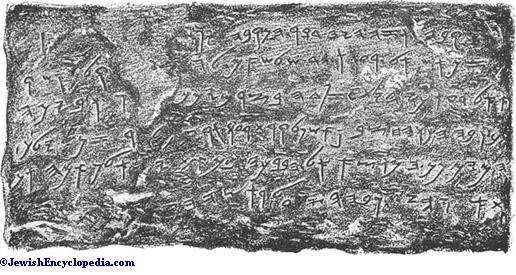




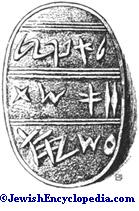

Other smaller inscriptions with Old Hebrew characters occur as "factory-marks" upon clay vessels, which were found in Jerusalem, in Tell-es-Safi, and in Tell-Zakariya (southwest of Hebron). These are probably the product of the royal potteries which existed in the different cities, and in addition to the word  , "to the king," the seals mention also the name of the town in which the pottery was situated (compare Lidzbarski, "Ephemeris," i. 54; Palestine Exploration Fund, Quarterly Statement, July, 1900, pp. 207 et seq. The following town-names have been found: Socho, Zif, Ezer, Ḥori, Hebron. This explanation of the legends is due to Clermont-Ganneau and Canon Dalton. It is more acceptable than the other which would see here the name of the king or some other person. The illustration accompanying this text shows
, "to the king," the seals mention also the name of the town in which the pottery was situated (compare Lidzbarski, "Ephemeris," i. 54; Palestine Exploration Fund, Quarterly Statement, July, 1900, pp. 207 et seq. The following town-names have been found: Socho, Zif, Ezer, Ḥori, Hebron. This explanation of the legends is due to Clermont-Ganneau and Canon Dalton. It is more acceptable than the other which would see here the name of the king or some other person. The illustration accompanying this text shows  and
and  . These smaller monuments of epigraphyand most of the seals date from preexilic times. Like the Hebrew language, the Hebrew Alphabet at this time was almost exclusively used in Palestine. Only the upper classes, who were in relations with foreign lands, spoke and wrote Aramaic (II Kings, xviii. 26; compare G. Hoffmann, in Stade's "Zeitschrift," i. 337, note 1 to Isa. viii. 1). But a marked change took place after the Babylonian exile. The Aramaic language, which had then already spread over the whole of Asia Minor, though used by the side of the local dialects, was gradually accepted by the Jews, together with its script. But inasmuch as the Hebrew was still used as the literary, the "holy," language, the writers did not altogether give up the use of the ancient Hebrew characters.
. These smaller monuments of epigraphyand most of the seals date from preexilic times. Like the Hebrew language, the Hebrew Alphabet at this time was almost exclusively used in Palestine. Only the upper classes, who were in relations with foreign lands, spoke and wrote Aramaic (II Kings, xviii. 26; compare G. Hoffmann, in Stade's "Zeitschrift," i. 337, note 1 to Isa. viii. 1). But a marked change took place after the Babylonian exile. The Aramaic language, which had then already spread over the whole of Asia Minor, though used by the side of the local dialects, was gradually accepted by the Jews, together with its script. But inasmuch as the Hebrew was still used as the literary, the "holy," language, the writers did not altogether give up the use of the ancient Hebrew characters.
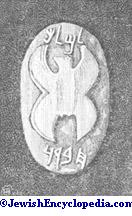
During the first centuries after the Exile, the Jews certainly used Hebrew in their writings. From this period up to the time of the Maccabees there are extant no monuments bearing inscriptions; for the following one there exist many remains, though in small dimensions, being mainly confined to coins. One would think that the characters used on a coin would be those most widely known; and, indeed, in Syria, Aramaic script and language are principally used upon coins. But the right to coin money was in olden times as to-day looked upon as a sign of political independence. Therefore, when the Jews, after their successful revolt against the Seleucids, felt themselves masters in their own land, they not only wanted to have their own coins, but, to give more forceful expression to their newly won independence, they inscribed legends in their own language and their own script. The letters on these coins resemble very closely those of the Siloam inscriptions and the smaller monuments. But what is there evidently the flourish of the reed as it hurried over the surface, or an imitation of it, appears here in fixed form. The curved stems of the old script have been broken at right angles, upon the lower leg of which the letter appears to rest. The appended stroke and flourishes, which before appeared accidental, became essential parts of the letter, while other original parts have been considerably reduced. Another peculiarity of this writing is the freedom observed in placing the character (see Plate I., cols. 4-6). For about a hundred years these characters were used upon the coins; they were then supplanted by the Greek.

 B,
B, 
Not until the revolts against Nero and against Hadrian did the Jews return to the use of the old Hebrew script on their coins, which they did from similar motives to those which had governed them two or three centuries previously; both times, it is true, only for a brief period (see Coins, and Bibliography 6). In addition to the above, there exists only one other small monument bearing the same sort of letters. It is the capital of a column, discovered in 1881 by M. Clermont-Ganneau near Amwâs, with the inscriptions  and Έῖς θεός
and Έῖς θεός
While the Jews adopted the Aramaic alphabet, gradually abandoning their own, the Samaritans held fast to the original forms, in order to show themselves the veritable heirs of ancient Hebraism. They then not only used the Hebrew text for sacred books, but employed it in secular writings as well, and later on even used it for both Aramaic and Arabic. The letters already adorned with angles and corners were still further overloaded under their hands and developed into a sort of Gothic (see Plate I., cols. 8-10). It is the same character used in all the Samaritan books of to-day, and remains the only offshoot of the old Hebrew script extant, while the modern Hebrew Alphabet is of Aramaic origin.
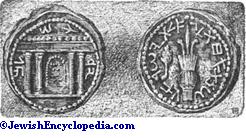
 B,
B, 

The Aramaic characters had undergone many changes in development before the Jews became acquainted with them. The oldest monuments with this alphabet are those discovered, about ten years ago, in or near the ruined mound of Zingirli, north of Nicopolis (Islaḥîe), and dating from the eighthcentury
These dockets, written entirely in cursive characters, are of special scientific value, because they allow us to follow up, step by step, the transition of the Aramaic alphabet from the original form to that in which it became known to the Jews in Babylonia, and even through some later developments (see plate II., col. 3). During that period the alphabet had undergone material changes, and at its close scarcely a symbol retained the form of three centuries before. The letters ג, ד, ד exemplify this evolution in a characteristic manner. Originally they were written with closed heads ( ) though, in writing rapidly, less and less attention was paid to the juncture of the lines. But what was at first only negligence became later a fixed custom. The heads were opened more and more, and the former convergent strokes developed into parallel lines, so that these three letters took on the following forms:
) though, in writing rapidly, less and less attention was paid to the juncture of the lines. But what was at first only negligence became later a fixed custom. The heads were opened more and more, and the former convergent strokes developed into parallel lines, so that these three letters took on the following forms:  . In 'Ayin (O) the circle opened more and more until the curve
. In 'Ayin (O) the circle opened more and more until the curve  became an angle open at the top: ∨. In Aleph (
became an angle open at the top: ∨. In Aleph ( ) the sides of the angle separated, the upper one moving more and more to the right and becoming unrecognizably small. So also in Kaph
) the sides of the angle separated, the upper one moving more and more to the right and becoming unrecognizably small. So also in Kaph  : the upper side of the angle is moved to the left and placed perpendicularly at the end of the other leg; thus כ became
: the upper side of the angle is moved to the left and placed perpendicularly at the end of the other leg; thus כ became  , and therewith came to resemble closely ד and ר. In He the lower horizontal lines were detached from the perpendicular, one of them was gradually omitted, and the other attached to the horizontal cross-bar, as
, and therewith came to resemble closely ד and ר. In He the lower horizontal lines were detached from the perpendicular, one of them was gradually omitted, and the other attached to the horizontal cross-bar, as  . The metamorphosis of
. The metamorphosis of  took place by the reduction of the head until it became entirely flat and ד is curved to a ך. Again in Zayin and Yod the double curved line
took place by the reduction of the head until it became entirely flat and ד is curved to a ך. Again in Zayin and Yod the double curved line  is gradually straightened, the former becoming
is gradually straightened, the former becoming  , while Yod develops into
, while Yod develops into  , which sign is gradually made smaller until it is reduced to scarcely more than a mere dot. In Ḥet, the central horizontal stroke only was retained, and was moved more and more to the top:
, which sign is gradually made smaller until it is reduced to scarcely more than a mere dot. In Ḥet, the central horizontal stroke only was retained, and was moved more and more to the top:  . In Ṭet, too, one line of the cross was omitted and the other fastened to the now open circle so that the letter could be made with one stroke: ט. In the case of Mem and Shin the broken line
. In Ṭet, too, one line of the cross was omitted and the other fastened to the now open circle so that the letter could be made with one stroke: ט. In the case of Mem and Shin the broken line  first becomes
first becomes  and for the latter of these two letters the middle stroke is then made parallel with the right one, so that a new sign results,
and for the latter of these two letters the middle stroke is then made parallel with the right one, so that a new sign results,  , while in the case of Mem
, while in the case of Mem  becomes
becomes  or
or  . In this latter form the straight stroke ׀ extends above the curved line and soon becomes greatly lengthened. Similarly the head of
. In this latter form the straight stroke ׀ extends above the curved line and soon becomes greatly lengthened. Similarly the head of  is transformed into a zigzag
is transformed into a zigzag  , and gradually becomes
, and gradually becomes  which is simplified to
which is simplified to  . The circular head in ḳoph was at first not closed; it becomes first
. The circular head in ḳoph was at first not closed; it becomes first  , and then by the addition of a hook to the left is changed to ק. In Tav, the cross-line
, and then by the addition of a hook to the left is changed to ק. In Tav, the cross-line  forms an angle, the right side of which is lengthened until it reaches the base
forms an angle, the right side of which is lengthened until it reaches the base  .
.
The particular form given to these Aramaic letters with ink upon papyrus, at the close of this evolutionary period—that is, about the fifth or fourth century
An extended private epistolary correspondence among the Jews of Palestine at that time could hardly have existed; nearly all writing was limited probably to literary productions, or to commercial and official documents. For the former, the indigenous script could very well be retained, and since literature was mostly confined to the priests, it is also tolerably certain that they at least remained faithful to the ancient mode of writing. On the contrary, all official or semi-official documents had to be written in Aramaic. It became, therefore, necessary for business people to learn two alphabets, one for their social needs and the other to enable them to read the Holy Scriptures. Naturally Jews who lived in foreign lands, and whose numbers continually grew, were especially compelled to do this, which circumstance no doubt furnished a reason for writing even the holy books in the Aramaic character; and these established themselves so firmly, that they were regarded at the time of the Mishnah as the only sacred ones (compare Mishnah Yadayim, iv. 5).
The opinion, therefore, has been expressed that the Hebrew Alphabet slowly developed into the Aramaic (compare Bleek-Wellhausen, "Einleitung in das Alte Test." 5th ed., p. 551), but this view can hardly be upheld. Among the Jews the two alphabets co-existedside by side, though this by no means precludes the possibility that a writer, either from ignorance or inadvertence, may have occasionally inserted Aramaic letters into his Hebrew text, or vice versa. Such errors would occur especially when the parallel letters differed very slightly. That this mixing of the letters occurred in the inscription below, which is regarded by authorities as the oldest one with square characters, may be due to chance. The inscription consists of only five letters, and not all even of these can be identified with certainty.
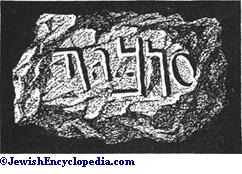
According to both Jewish and Christian tradition, the introduction of the Aramaic script and its use for the Holy Scriptures are directly attributed to Ezra the scribe (see Sanh. 21b, 22a; Yer. Meg. 71a; Origen, ed. Migne, ii., col. 1104: Jerome, "Prologus Galeatus"). The former statement is certainly not correct; nor can the latter be established satisfactorily. Supposing the introduction of the Aramaic script to have taken place in the fifth century or even later, the older manuscripts would hardly have been destroyed on that account. At all events, this much is assured, that, irrespective of the Samaritans, the knowledge of the older script still existed among the Jews for several centuries (Meg. ib.; Origen, "Hexapla" on Ezek. ix. 4, quotes the testimony of a converted Jew).
The 'AraḲ-el-Emir Inscription.Ancient monuments with square letters are very rare. That at 'Araḳ-el-Emir, referred to above, southeast of Es-Salt on the Wadi es-Sîr, may be considered the oldest (see Chwolson, "Corpus Inscriptionum Hebraicarum," 1; Lidzbarski, "Handbuch," pp. 117, 190, 484). It consists of one single word, the correct reading of which is probably  . The cavern in which it is found is generally identified as the one which, according to Josephus ("Ant." xii. 4, § 11), was built by Hyrcanus, nephew of the high priest Onias II., in the land of the Ammonites when he fled thither. Since this flight took place in the year 183
. The cavern in which it is found is generally identified as the one which, according to Josephus ("Ant." xii. 4, § 11), was built by Hyrcanus, nephew of the high priest Onias II., in the land of the Ammonites when he fled thither. Since this flight took place in the year 183
Notwithstanding the lack of care in the execution of the inscriptions and in spite of their uninteresting details, these stone chests possess an appreciable value, because by their aid may be traced the development of the square letters into characters which do not greatly differ from the present ones.






Even before the formation of the square characters, most of the letters could already be made with one stroke. But the attempt was presently made to give them such forms that a whole word might be written with as few breaks as possible, and each letter be gradually made to approach as near as possible the one following; thus in some of the letters which were originally closed by a perpendicular ( ) line, this line was bent toward the left. But this bending of the perpendicular line took place naturally only when ligature with the next letter was desirable or permissible; when the letter stood at the end of the word, the change in the sign was unnecessary, and the final letters ץ, ף, ז, ד still retained their original downward stroke; though they are considerably lengthened in the forms of our presentletters. In the letter מ the original bent stem was curved upward still more until it reached the upper horizontal stroke, so that the final Mem to-day has the form ם. The Palmyrene script possesses a final Nun with a lengthened stem; the Nabatean contains similarly final Kaph, Nun, Ẓade, and Shin, and further a closed final Mem and final He. In the same manner as exhibited in final Mem the zigzag on the head of Samek developed into a straight line, and—as was the case in the Palmyrene and Syriac script—the stem was again bent upward, so as to reach the upper horizontal line; but it remained open for a longer period than Mem (compare, for the two letters, also Shab. 104a). As a result of the effort to approach the letter following it, the hook on Lamed has been lengthened and advanced more and more toward the front until it finally became ל. So also in the case of ∨ the right side was prolonged beyond the point of intersection and finally produced ע. In such letters as ר, ד, and ן the stem could not be bent to the left without conflicting, the first two with the letters ב, כ, and the third with נ. But since the head of ו gradually disappeared or became nothing but a short stroke, the whole letter approached very closely to ן, which even in the Persian times had been reduced to a mere ׀. But, in order to distinguish the one from the other, it was found necessary to add a small stroke on the left side of Vaw, thus ן. The treatment of Yod varied: it often occurs with a stroke on the left side, a remnant of the lower horizontal line; but this line was very insignificant and often was not written at all. The stem, as a rule, was made very small (Matt. v. 18, ὶῶτα ἓν ἢ μία κεραία); though, in order to make its form harmonize more nearly with that of the other letters, it was occasionally lengthened and then resembled the ו. In the earliest editions of the Septuagint, it is said that the Tetragram was written in Hebrew characters which looked like the Greek ΠλΠλ (Jerome, ed. Migne, i. 429; see also Gesenius, "Gesch. d. Hebräischen Sprache und Schrift," p. 176).
) line, this line was bent toward the left. But this bending of the perpendicular line took place naturally only when ligature with the next letter was desirable or permissible; when the letter stood at the end of the word, the change in the sign was unnecessary, and the final letters ץ, ף, ז, ד still retained their original downward stroke; though they are considerably lengthened in the forms of our presentletters. In the letter מ the original bent stem was curved upward still more until it reached the upper horizontal stroke, so that the final Mem to-day has the form ם. The Palmyrene script possesses a final Nun with a lengthened stem; the Nabatean contains similarly final Kaph, Nun, Ẓade, and Shin, and further a closed final Mem and final He. In the same manner as exhibited in final Mem the zigzag on the head of Samek developed into a straight line, and—as was the case in the Palmyrene and Syriac script—the stem was again bent upward, so as to reach the upper horizontal line; but it remained open for a longer period than Mem (compare, for the two letters, also Shab. 104a). As a result of the effort to approach the letter following it, the hook on Lamed has been lengthened and advanced more and more toward the front until it finally became ל. So also in the case of ∨ the right side was prolonged beyond the point of intersection and finally produced ע. In such letters as ר, ד, and ן the stem could not be bent to the left without conflicting, the first two with the letters ב, כ, and the third with נ. But since the head of ו gradually disappeared or became nothing but a short stroke, the whole letter approached very closely to ן, which even in the Persian times had been reduced to a mere ׀. But, in order to distinguish the one from the other, it was found necessary to add a small stroke on the left side of Vaw, thus ן. The treatment of Yod varied: it often occurs with a stroke on the left side, a remnant of the lower horizontal line; but this line was very insignificant and often was not written at all. The stem, as a rule, was made very small (Matt. v. 18, ὶῶτα ἓν ἢ μία κεραία); though, in order to make its form harmonize more nearly with that of the other letters, it was occasionally lengthened and then resembled the ו. In the earliest editions of the Septuagint, it is said that the Tetragram was written in Hebrew characters which looked like the Greek ΠλΠλ (Jerome, ed. Migne, i. 429; see also Gesenius, "Gesch. d. Hebräischen Sprache und Schrift," p. 176).
Of the upper transverse line in Aleph only the left side remains, and in order to reach the base-line, it was gradually lengthened. The same is the case with נ, though there as well as in Aleph, the whole left member of the letter is pushed to the bottom. In the letter He the former lower horizontal line is gradually made parallel to the vertical stem and fastened to the upper cross line, from which, by a process of shortening, it has been separated only since the Middle Ages. Some of the older forms of this letter show an extension of the right-hand stem above the cross-bar. In the case of Ḥet H = ח, a system of curtailment affected the upper horns of this letter, gradually reducing it to its present form. An extension of the upper part of Tav is also noticeable in the older forms of this letter, which causes the Tav to approach in appearance the corresponding Syrian sign. As early as the middle-Aramaic period the letters ט, ק, ש appear in forms almost identical with those now in use, though in the older ḳ;oph the stem is not longer than in the other letters, and it hangs from the horizontal line; the stems of the Shin are drawn together to a point, and often the left-hand stem passes beyond this point. Compare Plate III., cols. 2, 3, and Talmud Shab. 104a.
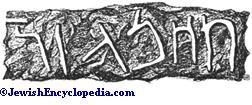

The only inscriptions in square characters dating from the time of the destruction of Jerusalem are: (1) the monuments marking the boundaries of Gezer (see "C. I. H." ii.; compare also Lidzbarski, "Handbuch," p. 484, and "Ephemeris," i. 56), and (2) the bilingual legends upon the sarcophagus of Queen Ẓadda (see illustration below). Up to now (1901), five of these boundary-stones have been discovered, thanks to Clermont-Ganneau; they served to indicate the town limits of Gezer, beyond which it was forbidden to pass on the Sabbath. The sarcophagus bears the short legend  , which is repeated in Syriac. The queen or princess
, which is repeated in Syriac. The queen or princess  here referred to has been identified as the princess Helena of Adiabene, who is said to have settled in Jerusalem about the year 40 of the common era. From the fact that it preserves the oldest Syriac inscription known this bilingual stone possesses additional value. Several fragmentary inscriptions found in Jerusalem and vicinity may be assigned to the first centuries of the common era (Chwolson, Plate I., Nos. 3, 4, 7, 9). To the third and fourth centuries belong the inscriptions found in the synagogues of Kefr-Bir'im in Galilee, northwest of Safed; see illustration on following page.
here referred to has been identified as the princess Helena of Adiabene, who is said to have settled in Jerusalem about the year 40 of the common era. From the fact that it preserves the oldest Syriac inscription known this bilingual stone possesses additional value. Several fragmentary inscriptions found in Jerusalem and vicinity may be assigned to the first centuries of the common era (Chwolson, Plate I., Nos. 3, 4, 7, 9). To the third and fourth centuries belong the inscriptions found in the synagogues of Kefr-Bir'im in Galilee, northwest of Safed; see illustration on following page.
Older even than these are the inscriptions over the Synagogue in Palmyra, which contain the Shema'. (See Plate II., col. 7; compare S. Landauer in "Sitzungsberichte der Berliner Academie," 1884, p. 933, and Ph. Berger, "Histoire de l'Écriture," 2d ed., p. 259.) The characters on the walls of the catacombs of Venosa are also very old, and belong probably to the period between the second and the fifth centuries; most of them are painted in red lead. Till now the oldest gravestones have been found in Italy (compare Ascoli, "Iscrizioni Inedite o Mal Note Grecche, Latine, Hebraiche di Antichi Sepolcri Giudaici," in the "Transactions" of the fourth Oriental Congress in Florence, published at Turin and Rome, 1880, and also "C. I. H." No. 24 et seq.). See Plate III., cols. 7 and 8.

The number of inscriptions relating to this period is very small, and their contents are of little importance. Owing to the many upheavals which took place, notably in Palestine, during this interval, much epigraphic material was undoubtedly destroyed, though it is certain that if very many monuments had been produced the existing remains would have been much greater. From the mode of execution it would appear that then there was not much activity in epigraphic work, for the script seems to come from inexperienced, clumsy hands. Compared with it, the de-degree of perfection to which the Palmyrene script had arrived is striking, though this in essence is the same as the Hebrew square script (compare Plate II., col. 7). The Nabatean alphabet also in a comparatively short period developed into a smooth and pleasing cursive, due entirely to the repeated effort to connect the letters with each other. The connection of single characters in words occurred even in the inscriptions of the Bene Ḥezir, but the general acceptance of ligature was systematically opposed. Suchat least was the case with the text of the Holy Scripture, as is proven by testimony of Men. 29a ("Any letter not entirely surrounded by clear parchment on all four sides is unlawful"). This injunction has not been barren of effect; for, despite the various modifications through which the Hebrew Alphabet has passed, of all the Semitic systems of letters it has departed least from its fundamental form. Nothing alters the individuality of the letters so much as the use of ligature, because the little stroke which serves to unite the letters is often made too important a factor, so that the letter sometimes is merged entirely in it. This is most clearly exemplified in modern Arabic.
Ornamentation of Letters.As has already been remarked, specimens of writing from the oldest periods are afforded only by inscriptions; there are no manuscripts. And yet it may be safely asserted that toward the end of the ancient period the holy books were written substantially as now. A passage in the Talmud even declares that those small "ornaments," as they are called, the three  or
or  placed over the seven letters
placed over the seven letters  , were at the time not only customary but obligatory (Men. 29b). Whether written with ו or י, these signs were originally nothing more than ornaments which accidentally took the form of Zayin, and the letters which received them were simply all those which ended in a perpendicular stroke; for the heads that they now possess are of a later origin. At first they may have been nothing but thicker points, such as were made to terminate the strokes of the Samaritan ornamental writing (compare Plate I., col. 10), and since the great majority of the letters begin with a horizontal stroke, habit may have led the writer to add a small horizontal stroke to the others. ו and י are not included in the letters
, were at the time not only customary but obligatory (Men. 29b). Whether written with ו or י, these signs were originally nothing more than ornaments which accidentally took the form of Zayin, and the letters which received them were simply all those which ended in a perpendicular stroke; for the heads that they now possess are of a later origin. At first they may have been nothing but thicker points, such as were made to terminate the strokes of the Samaritan ornamental writing (compare Plate I., col. 10), and since the great majority of the letters begin with a horizontal stroke, habit may have led the writer to add a small horizontal stroke to the others. ו and י are not included in the letters  , because the stroke at the top is a part of their original form (see Plate III., col. 2); hence these two letters did not receive any of the
, because the stroke at the top is a part of their original form (see Plate III., col. 2); hence these two letters did not receive any of the  . (For further information concerning the
. (For further information concerning the  and the
and the  of the letters compare J. Derenbourg's work cited in Bibliography, § 9, end of this article.) There is this further possibility, that these marks are dia-critical. It may readily be supposed that ז received such a mark in order to distinguish it from ו and י; נ, to avoid confusion with כ; still this hypothesis is not tenable for all the letters. It would be just as difficult to determine why ק, ה, ד, ב, and in many manuscripts the letters י and ח, should receive a zayin. (For the form of the letters with these zayinin in modern German manuscripts, see Plate IV., col. 7.) It is certain that Ḥet received its "roof" (Men. 29a; compare also col. 24) solely in order to differentiate it from ה.
of the letters compare J. Derenbourg's work cited in Bibliography, § 9, end of this article.) There is this further possibility, that these marks are dia-critical. It may readily be supposed that ז received such a mark in order to distinguish it from ו and י; נ, to avoid confusion with כ; still this hypothesis is not tenable for all the letters. It would be just as difficult to determine why ק, ה, ד, ב, and in many manuscripts the letters י and ח, should receive a zayin. (For the form of the letters with these zayinin in modern German manuscripts, see Plate IV., col. 7.) It is certain that Ḥet received its "roof" (Men. 29a; compare also col. 24) solely in order to differentiate it from ה.

 ("May peace abide within this [holy] place and in all [holy] places of Israel! Jose ha-Levi, son of Levi, erected this lintel; blessing attend his works (?) !")
("May peace abide within this [holy] place and in all [holy] places of Israel! Jose ha-Levi, son of Levi, erected this lintel; blessing attend his works (?) !")As regards the names given to the Hebrew alphabets at the time of the Mishnah and the Gemara, the name ketab 'Ibri (Hebrew writing) needs no further explanation. Perhaps Rabbi Jose may be correct in his explanation of the term ketab Ashuri as the name for the modern script; according to him  is equivalent to Ασσυρία, Συρία, and
is equivalent to Ασσυρία, Συρία, and  therefore meant Syriac, Aramaic. Of interest also is an expression of Rabbi Judah which shows that the contrast between the straight lines and stiffness of the Aramaic, as compared with the angular irregularity of the Samaritan, was considered quite striking.
therefore meant Syriac, Aramaic. Of interest also is an expression of Rabbi Judah which shows that the contrast between the straight lines and stiffness of the Aramaic, as compared with the angular irregularity of the Samaritan, was considered quite striking.
Influence of Ligature.Much more difficult to understand are the other names for the Hebrew script:
and
; for
the reading
most often occurs, denoting the "broken" script. Again, in Stade's "Zeitschrift," i. 336, G. Hoffmann, referring to this appellation, says that in Epiphanius ("De Gemmis," xii. 63) this same script is called "deession," "deessenon," consequently
would be the correct reading; and according to Hoffmann also, ketab Da'aẓ meant first styliform script, and afterward script (used on coins). Both Hoffmann and Halévy ("Mélanges de Critique et d'Histoire," p. 435, Paris, 1883) recognize in
an adjective from the name of some locality. The former, with R. Hananeel in the Tosafot, adopts the reading
for the place (north of Neapolis), while the latter reads
(Neapolis). Since R. Ḥisda was a Babylonian it is quite conceivable that he was unacquainted with the Samaritan alphabet, and that he regarded the ancient forms as identical with those found upon the clay tablets—
. This opinion of R. Ḥisda may have been strengthened by the existence of the name
. According to R. Nathan, who was likewise a Babylonian, the theory might be held that ketab Da'aẓ stood for styliform, incisive, or cuneiform text. Though this form of writing may not have been practised at this time, yet, both then and later, the rubbish of the old ruins supplied in numbers clay tablets covered with these characters, sufficient to perpetuate the knowledge that this was the form of the ancient script. A mention of the clay tablet inscriptions may be found even in the Fihrist of the An-Nadîm, composed in the year 987 (compare M. Jastrow, Jr., in "Zeit. f. Assyi." x. 99).
Owing to the inflexible rules governing the writing of the Torah rolls there could not be any material variation in the form of their letters. The great importance, however, which was attached to these manuscripts led to great care in the execution of the characters; the scribes strove to produce the most beautiful effect so far as could be done within the prescribed limitations. In the case of alphabets having a highly developed system of ligature, like the Arabic, the writer might obtain good results by artistic grouping of letters, but in a block text, such as the Hebrew, in which every letter must be strictly separated, efforts in the direction of ornamentation were confined to the individual letter. Hence the Hebrew script followed the same development undergone previously by the Palmyrene. Even at the early period when the Aramaic alphabet branched out into the Hebraic, Palmyrene, and Arabic, the symbols had an almost rectangular form (compare Lidzbarski, "Handbuch," Table XXVI., col. 4), and developed until the characters became almost perfect squares, and thus formed the ketab merubba' ("square writing").
Influence of Writing Material.From the earliest days, throughout West Asia writing was done with the calamus, imported in most cases from Egypt. Since this reed was easilybroken it was not found practical to make too sharp a point, and this circumstance resulted in producing an instrument analogous to the modern stub pen, which gave the characters in all texts of West Asia the form of a "round hand." The heavy and light strokes in the letters alternate in such a manner that gradually the horizontal strokes become heavy, while the perpendicular ones naturally diminish in thickness. Such a modification took place in the Hebrew, and all the horizontal strokes were made thick. As has been remarked above, the scribes, probably from force of habit, added even to the letters beginning with upright stems a short thin stroke quite similar to the little ornaments on the letters  . The reed pen ("habilis calamus") glided easily over the surface. Consequently, wherever it was used as an instrument for writing—that is, in Saracen lands—the characters, in spite of being in the square form, show a tendency to roundness, the vertical strokes at the same time becoming more or less inclined at an angle. In the Occident, however, the quill was used, which offered a similar obstacle to sharp pointing, and as a consequence it assumed in its results much the character of the calamus. On the other hand, the walls of the quill are much thinner than those of the reed; and this gave rise to an appreciable difference between the pen-stroke and one made by the calamus. The ability of the quill to retain a sharper nib adapted it especially to the finer strokes of the letters, but its comparative flexibility led more easily to the breaking of the lines. Again, since the nibs of the quill pen parted very easily, in fact spread so far asunder that the ink failed to fill out the space between them, distinct scratches would sometimes make their appearance at the beginning, or sometimes at the end, of a thick stroke. In the Saracenic, or, as they were called, Sephardic (Spanish) lands the Hebrew Alphabet is distinguished for its roundness, for the small difference between the thickness of the horizontal and upright strokes as well as for the inclined position of the letters. The script of the Christian Occident—called Ashkenazic from the Hebrew name for Germany, where the Jews were the most populous—shows sharper corners, thinner upright stems, broken and pointed lines. Several minor peculiarities arose also in the letters ג, צ, ק.
. The reed pen ("habilis calamus") glided easily over the surface. Consequently, wherever it was used as an instrument for writing—that is, in Saracen lands—the characters, in spite of being in the square form, show a tendency to roundness, the vertical strokes at the same time becoming more or less inclined at an angle. In the Occident, however, the quill was used, which offered a similar obstacle to sharp pointing, and as a consequence it assumed in its results much the character of the calamus. On the other hand, the walls of the quill are much thinner than those of the reed; and this gave rise to an appreciable difference between the pen-stroke and one made by the calamus. The ability of the quill to retain a sharper nib adapted it especially to the finer strokes of the letters, but its comparative flexibility led more easily to the breaking of the lines. Again, since the nibs of the quill pen parted very easily, in fact spread so far asunder that the ink failed to fill out the space between them, distinct scratches would sometimes make their appearance at the beginning, or sometimes at the end, of a thick stroke. In the Saracenic, or, as they were called, Sephardic (Spanish) lands the Hebrew Alphabet is distinguished for its roundness, for the small difference between the thickness of the horizontal and upright strokes as well as for the inclined position of the letters. The script of the Christian Occident—called Ashkenazic from the Hebrew name for Germany, where the Jews were the most populous—shows sharper corners, thinner upright stems, broken and pointed lines. Several minor peculiarities arose also in the letters ג, צ, ק.
Within the range of these distinct features, in different countries various gradations and transitions occur; thus the characters used by the Jews of Southern France and Italy, owing to their proximity to the Jews of Spain, and those used by the Greek Jews, owing to their relations with their Oriental coreligionists, assumed a rounder form than the strictly Ashkenazic. The Ashkenazic alphabets may be divided, therefore, into a German, a northern and a southern French ( ); an Italian (
); an Italian (
 ), and a Greek branch. Among the Sephardim there are fewer variations noticeable, yet it is possible to distinguish in the Sephardic alphabet variations due to North African, Palestinian, and Babylonian-Persian Jews. The same script used for the Torah rolls is employed for the rest of the Biblical books or other important works, only in this case the
), and a Greek branch. Among the Sephardim there are fewer variations noticeable, yet it is possible to distinguish in the Sephardic alphabet variations due to North African, Palestinian, and Babylonian-Persian Jews. The same script used for the Torah rolls is employed for the rest of the Biblical books or other important works, only in this case the  and the roof of the Ḥet are omitted. In other works, however, embellishments and flourishes occur which were strictly prohibited in the preparation of the Torah. These ornamentations were influenced by the miniature illuminations used by Christians, and sometimes even artists of that faith were employed. Two works, freely used among the people, were thus especially illuminated, the Megillah (Book of Esther) and the Haggadah for Passover.
and the roof of the Ḥet are omitted. In other works, however, embellishments and flourishes occur which were strictly prohibited in the preparation of the Torah. These ornamentations were influenced by the miniature illuminations used by Christians, and sometimes even artists of that faith were employed. Two works, freely used among the people, were thus especially illuminated, the Megillah (Book of Esther) and the Haggadah for Passover.
In the St. Petersburg Imperial Public Library may be found the oldest Hebrew Bible manuscript extant. It dates from 916-917, and the letters are in general the same as those made now, though several slight modifications appear. Thus in ד and ה the horizontal line projects to the right over the upright, besides in ה and in ק the left stem hangs from the cross beam. י is comparatively long, but ו not longer than the other letters (see Plate IV., col. 1). One or two centuries earlier is the manuscript of Ecclesiasticus discovered in Egypt, in which all these characteristics are wanting, but the very peculiar width of the lower part in ש may be noted (ib. col. 2). Columns 3, 4, and 5 in Plate IV. exhibit other Oriental alphabets; those of the Ashkenazim may be illustrated by specimens from illuminated German manuscripts. For the former, compare cols. 1-5; col. 6, in which the cusped letters predominate, is taken from a German Seliḥot manuscript of the thirteenth or fourteenth century (Steinschneider, "Verzeichniss der Hebr. Handschriften," Berlin, i. 4, 9; Tab. ii. 3). The more secular the work, the less importance was attached to it, and the less care was taken that the execution of its letters should conform to the rules set down for the writing of the Holy Scriptures, and be, as it was called, a  (see Sifre on Deut. xxxvi.
(see Sifre on Deut. xxxvi.  ). In the Talmud (Shab. 103b) ketibah tammah means simply "correct" script, but later it was applied to the square as opposed to the cursive alphabet; thus Maimonides' statement (compare Steinschneider, "Vorlesungen über Hebräische Handschriften," p. 29), that the ketab tam designates the German square script as compared with the Oriental, seems to rest on an error.
). In the Talmud (Shab. 103b) ketibah tammah means simply "correct" script, but later it was applied to the square as opposed to the cursive alphabet; thus Maimonides' statement (compare Steinschneider, "Vorlesungen über Hebräische Handschriften," p. 29), that the ketab tam designates the German square script as compared with the Oriental, seems to rest on an error.
Still less care was taken in the execution of the letters in cases where the text transcribed was not even Hebrew. For though it is true that within their own country the Jews, in exchanging their language for that of another nation, adopted also the alphabet of that nation, yet, throughout the Diaspora, the vernacular of the country, which was invariably adopted by the Jews, was written by them with Hebrew characters. So that, whether the vernacular be German, French, Spanish, Italian, Arabic, Persian, or even Tatar, as is the case with the Karaites of Southern Russia, the Hebrew was the alphabet used. Accordingly there grew up in coexistence with the square a cursive script, the tendency of which was to give the letters such forms as would permit their being more easily and rapidly made. But the mandate against the use of the ligature in connection with the writing of the sacred texts was powerful enough to influence the development of this system of writing also; for the ligature occurs comparatively seldom even in the cursive script. Thus a most potent factor in the transformation of the alphabet was held in restraint.
The primal difference between the two alphabets, square and cursive, was size. In unimportant works the lettering, for economy's sake, was small; such was also the case with marginal or explanatory notes. The former was called ketibah gassah, or "large script"; the smaller characters were known as ketibah daḲḲah or Ḳeṭannah, "small script" (compare Steinschneider, l.c., note 1, and Löw, "Graphische Requisiten," p. 73, where still other names for the various styles of script may be found). Through greater carelessness and haste in writing, the cornersof the square letters became somewhat rounded, and the heads were made smaller or disappeared altogether; later on, distinct modifications took place in some of the letters.
Cursive Script.The brief inscriptions daubed in red ink upon the walls of the catacombs of Venosa are probably the oldest examples of cursive script. Still longer texts in a cursive alphabet are furnished by the clay bowls found in Babylonia and bearing exorcisms against magical influences and evil spirits (see Bibliography 10). These no doubt date from the seventh or eighth century, and some of the letters are written in a form that is very antiquated (Plate V., col. 1). Somewhat less of a cursive nature is the manuscript, which dates from the eighth century (see Bibliography 11). Cols. 2-14 exhibit cursive scripts of various countries and centuries. The differences visible in the square alphabets are much more apparent. For instance, the Sephardic rounds off still more, and, as in Arabic, there is a tendency to run the lower lines to the left, whereas the Ashkenazic script appears cramped and disjointed. Instead of the little ornaments at the upper ends of the stems, in the letters  a more or less weak flourish of the line appears. For the rest the cursive of the Codices remains fairly true to the square text. Documents of a private nature were certainly written in a much more running hand, as the sample from one of the oldest Arabic epistles written with Hebrew letters (tenth century?) clearly shows in the papyrus, in "Führer durch die Ausstellung," Table XIX., Vienna, 1894, (compare Plate V., col. 4). But since the preservation of such epistles was not held to be of importance, material of this nature from the earlier times is very scarce, and as a consequence the development of the script is very hard to follow. The last two columns of Plate V. exhibit the German cursive script of a later date. The next to the last is taken from a manuscript of Elias Levita. The accompanying specimen presents Sephardic script. In this flowing cursive alphabet the ligatures appear more often. They occur especially in letters which have a sharp turn to the left (ג, ז, כ, נ, צ, ח), and above all in נ, whose great open bow offers ample space for another letter.
a more or less weak flourish of the line appears. For the rest the cursive of the Codices remains fairly true to the square text. Documents of a private nature were certainly written in a much more running hand, as the sample from one of the oldest Arabic epistles written with Hebrew letters (tenth century?) clearly shows in the papyrus, in "Führer durch die Ausstellung," Table XIX., Vienna, 1894, (compare Plate V., col. 4). But since the preservation of such epistles was not held to be of importance, material of this nature from the earlier times is very scarce, and as a consequence the development of the script is very hard to follow. The last two columns of Plate V. exhibit the German cursive script of a later date. The next to the last is taken from a manuscript of Elias Levita. The accompanying specimen presents Sephardic script. In this flowing cursive alphabet the ligatures appear more often. They occur especially in letters which have a sharp turn to the left (ג, ז, כ, נ, צ, ח), and above all in נ, whose great open bow offers ample space for another letter.
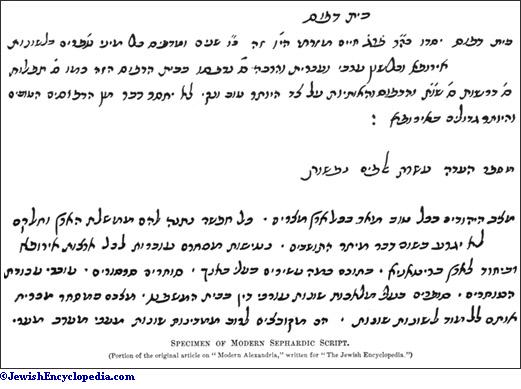
The following are the successive stages in the development of each letter: Aleph is separated into two parts, the first being written thus  , and the perpendicular stroke placed at the left
, and the perpendicular stroke placed at the left  . In the modern German cursive these two elements are separated, thus ׀c, and the acute angle was rounded. It received also an abbreviated form connected with the favorite old ligature
. In the modern German cursive these two elements are separated, thus ׀c, and the acute angle was rounded. It received also an abbreviated form connected with the favorite old ligature  , and it is to this ligature of Aleph and Lamed that the contracted Oriental Aleph owes its origin (Plate V., col. 7). In writing Bet, the lower part necessitated an interruption, and to overcome this obstacle it was made
, and it is to this ligature of Aleph and Lamed that the contracted Oriental Aleph owes its origin (Plate V., col. 7). In writing Bet, the lower part necessitated an interruption, and to overcome this obstacle it was made  , and, with the total omission of the whole lower line,
, and, with the total omission of the whole lower line,  . In Gimel, the left-hand stroke is lengthened more and more. Dalet had its stroke put on obliquely to distinguish it from Resh; however, since in rapid writing it easily assumed a form similar in appearance to ר, ד in analogy with ב was later changed to
. In Gimel, the left-hand stroke is lengthened more and more. Dalet had its stroke put on obliquely to distinguish it from Resh; however, since in rapid writing it easily assumed a form similar in appearance to ר, ד in analogy with ב was later changed to  . A transformation very similar to this took place in the cases of final Kaph and of ḳ;oph (see cols. 2, 5, 11, 14), except that ḳ;oph opened out a trifle more than Kaph. The lower part of Zayin was bent sharply to the right and received a little hook at the bottom. The left-hand stroke of Ṭet was lengthened. Lamed gradually lost its semicircle until (as in both the Nabatæan-Arabic and Syriacsystems) it became a simple stroke, which was bent sharply toward the right in the most modern cursive script. Final Mem branches out at the bottom, and in its latest stage is drawn out either to the left or straight down. In Samek the same development also took place, but it afterward became again a simple circle. In order to write 'Ayin without removing the pen from the surface, its two strokes were joined with a curl. The two Pe's spread out in a marked flourish. As to Ẓade the right-hand head is made longer, at first only to a small degree, but later on to a considerable extent. In the beginning Shin develops similarly to the same letter in the Nabatæan, but afterward the central stroke is lengthened upward, like the right arm of Ẓade, and finally it is joined with the left stroke, and the first stroke is left off altogether. The letters ה, ד, ח, ן, נ, ר, ת, have undergone little modification: they have been rounded out and simplified by the omission of the heads.
. A transformation very similar to this took place in the cases of final Kaph and of ḳ;oph (see cols. 2, 5, 11, 14), except that ḳ;oph opened out a trifle more than Kaph. The lower part of Zayin was bent sharply to the right and received a little hook at the bottom. The left-hand stroke of Ṭet was lengthened. Lamed gradually lost its semicircle until (as in both the Nabatæan-Arabic and Syriacsystems) it became a simple stroke, which was bent sharply toward the right in the most modern cursive script. Final Mem branches out at the bottom, and in its latest stage is drawn out either to the left or straight down. In Samek the same development also took place, but it afterward became again a simple circle. In order to write 'Ayin without removing the pen from the surface, its two strokes were joined with a curl. The two Pe's spread out in a marked flourish. As to Ẓade the right-hand head is made longer, at first only to a small degree, but later on to a considerable extent. In the beginning Shin develops similarly to the same letter in the Nabatæan, but afterward the central stroke is lengthened upward, like the right arm of Ẓade, and finally it is joined with the left stroke, and the first stroke is left off altogether. The letters ה, ד, ח, ן, נ, ר, ת, have undergone little modification: they have been rounded out and simplified by the omission of the heads.
When printing was introduced, the selection of a style of type depended upon the same conditions as in the case of the execution of manuscripts. Square or block letters were cast for biblical and other important works; in the various countries different models for letters were often followed; one form was preferred at one time, another at another; however, the style selected by the Ashkenazim prevailed and maintained its preeminence over all the others. Books of a secondary character, works which accompanied another text, such as commentaries and the like, were printed in the cursive; and here a style of type became popular which very closely resembled the Hispano-African cursive (compare Plate IV., col. 9). Since the script occurs oftenest in commentaries on the Bible and the Talmud by Rashi, it has become known as the Rashi script. For the printing of Judæo-German texts, a further development of the Ashkenazi alphabet, called "Weiber-Deutsch," has been created (compare Plate V., col. 13; see Bibliography 12).
- 1. Egyptian Origin of Alphabet: J. L. Saalschütz, Zur Geschichte der Buchstabenschrift, Königsberg, 1838;
- Archäologie der Hebräer, i. 323 et seq., Königsberg, 1855;
- J. Olshausen, Über den Ursprung des Alphabetes, in Philolologische Studien, i., Kiel, 1841;
- H. Brugsch, Über Bildung und Entwickelung der Schrift, in Virchow-Holtzendorff, Sammlung Gemeinwissenschaftlicher Vorträge, series iii, No. 64, Berlin, 1868;
- Em. de Rougé, Mémoire sur l'Origine Egyptienne de l'Alphabet Phénicien, Paris, 1874.
2. Assyrian Origin of Alphabet: W. Deecke, Der Ursprung des Altsemitischen Alphabets aus der Neuassyrischen Keilschrift, in Z. D. M. G. xxxi. 102 et seq.;- Friedrich Delitzsch, Die Entstehung des Ältesten Schriftsystems, pp. 221 et seq., Leipsic, 1897;
- H. Zimmern, Zur Frage nach dem Ursprung des Alphabets, in Z. D. M. G. i. 667 et seq.;
- Ball, The Origin of the Phenician Alphabet, in Proceedings of Soc. Bibl. Arch. xv. 392-408.
3. Moabite Stone: Lidzbarski, Handbuch der Nordsemitischen Epigraphik, i. 39 et seq., with the numerous works on the inscription, of which the following are the most prominent: Ch. Clermont-Ganneau, La Stèle de Dhiban ou Stèle de Mesa, Roi de Moab, Paris, 1870;- Th. Nöldeke, Die Inschrift des Königs Mesa von Moab, Kiel, 1870;
- K. Schlottmann, Die Siegessäule Mesa's, Königs der Moabiter, Halle, 1870;
- R. Smend and A. Socin, Die Inschrift des Königs Mesa von Moab, Freiburg, i. B. 1886;
- Ch. Clermont-Ganneau, La Stèle de Mesa, in Journal Asiatique, series viii., vol. ix. 72 et seq.;
- A. Nordlander, Die Inschrift des Königs Mesa von Moab, Leipsic, 1896;
- A. Socin and H. Holzinger, Zur Mesainschrift, Berichte über die Verhandlung der Königlichen Gesellschaft der Wissenschaft zu Leipzig, 1897, pp. 171 et seq.;
- M. Lidzbarski, Eine Nachprüfung der Mesainschrift, in Ephemeris für Semitische Epigraphik, i. 1 et seq.
4. Siloam Inscription: E. Kautzsch, Die Siloahinschrift in Zeit. Deutsch. Paläst. Ver. iv. 102 et seq., 260 et seq. (with reproductions by C. Schick and A. Socin);- H. Guthe, Die Siloahinschrift, in Z. D. M. G. xxxvi. 725 et seq.;
- E. J. Pilcher, The Date of the Siloam Inscription, in Proceedings Soc. Bibl. Arch. xix. 165 et seq.;
- C. R. Conder, Date of the Siloam Text, ib. pp. 204 et seq.;
- E. J. Pilcher and E. Davis, On the Date of the Siloam Inscription in Pal. Explor. Fund, Quarterly Statement, 1898, pp. 56 et seq., 76;
- Ch. Clermont-Ganneau, ib. pp. 158-167;
- A. Socin, Die Siloahinschrift, in Zeit. Deutsch. Paläst. Ver. xxii. 61 et seq.;
- M. Lidzbarski, Zur Siloahinschrift, in Ephemeris, i. 52 et seq.
5. Inscriptions on Seals: M. A. Levy, Siegel und Gemmen mit Aramäischen, Phönizischen, Althebräischen . . . Inschriften, Breslau, 1869;- Ch. Clermont-Ganneau, Sceaux et Cachets Israélites, Phéniciens, et Syriens, in Journal Asiatique, 1883, i. 123 et seq., 506 et seq., ii. 304 et seq.;
- Le Sceau de Obadyahau, Fonctionnaire Royal Israélite, in Revue Archéologique, series iii., vol. v. 1;
- Nouvelles Intailles à Légendes Semitiques, Comptes-rendus de l'Académie des Inscriptions, 1892, pp. 274 et seq., 1894, pp. 131 et seq.;
- Ph. Berger, ib. p. 340;
- Ch. Clermont-Ganneau, Le Sceau de Adoniphelet in Études d'Archéologie Orientale, i. 85 et seq.;
- R. Brünnow, Mitteilungen des Deutsch. Paläst. Ver. 1896, pp. 4 et seq., pp. 21 et seq.;
- Ch. Clermont-Ganneau, Un Nouveau Cachet Archaique, in Revue Archéologique, series iii., vol. xxviii. 348;
- E. Sachau, Aramäische Inschriften, in Sitzungsbericht der Berliner Akademie der Wissenschaften, 1896, p. 1064;
- B. Stade, Vier im Jahre 1896 Publizirte Altsemitische Siegelsteine, in Zeitschrift der Alttestamentlicher Wissenschaft, xvii. 204 et seq.;
- A. H. Sayce, Note on the Seal Found at Ophel in Pal. Explor. Fund, Quarterly Statement, 1897, p. 181 et seq.;
- further communications by Clermont-Ganneau, Pilcher, and Sayce, ib. pp.304 et seq.;
- Comptes-rendus de l'Académie des Inscriptions, 1897, pp. 374 et seq.;
- Revue Biblique, vi. 597;
- Ch. Clermont-Ganneau, Le Sceau de Elamas, Fils de Elichou, in Revue Archéologique, series iii., vol. xxx. 244 et seq.;
- Cachet Israélite aux Noms de Ahaz et de Pekhai, Recueil ii. 16;
- Cachet Israélite Archaique aux Noms d'Ishmael et Pedayahou, ib. pp. 251-253;
- Comptes-rendus, 1898, p. 812;
- Lidzbarski, Handbuch, p. 486;
- Ch. Clermont-Ganneau, Sceau Israélite au Nom d'Abigaïl, Femme de 'Asayahou, Recueil iii. 157 et seq.;
- Quatre Nouveaux Sceaux à Légendes Sémitiques, ib. pp. 188 et seq.;
- Lidzbarski, Ephemeris, i. 10 et seq.
6. Coin Inscriptions: M. A. Levy, Gesch. der Jüd. Münzen, Leipsic, 1862;- Fr. Madden, Coins of the Jews, London, 1881;
- Th. Reinach, Les Monnaies Juives, Paris, 1887.
7. Zendgirli or Sinjirli Inscriptions: Ausgrabungen in Sendschirli, Ausgeführt und Herausgegeben im Auftrage des Orient-Comité's zu Berlin, i., Berlin, 1893;- J. Halévy, Deux Inscriptions Sémitiques de Zindjirli in Revue Sémitique, i. 77 et seq.;
- Les Deux Inscriptions Hétéennes de Zindjirli, ib. pp. 138 et seq., 218 et seq., 319 et seq., ii. 25 et seq.;
- D. H. Müller, Die Altsemitischen Inschriften von Sendschirli, in W. Z. K. M. iii. 33 et seq., 113 et seq.;
- Th. Nöldeke, Bemerkungen zu den Aramäischen Inschriften von Sendschirli in Z. D. M. G. xlvii. 96 et seq.;
- J. Halévy, La Première Inscription de Bar Rekoub, Revue et Corrigée, in Rev. Sém. iv. 185 et seq.;
- D. H. Müller, Die Bauinschriften des Bar-rekub, in W. Z. K. M. x. 193 et seq.;
- E. Sachau, Aramäische Inschriften, in Sitzungsberichte der Preussischen Akademie der Wissenschaften, 1896, pp. 1051 et seq.;
- M. Lidzbarski, Handbuch, i. 440 et seq., ii. tables xxii.-xxiv.
8. Aramaic Inscriptions: Ch. Clermont-Ganneau, Les Stèles Araméennes de Neirab;- Études d'Archéologie Orientale, ii. 182 et seq.;
- Album, d'Antiquités Orientales, tables i., ii. Paris, 1897;
- G. Hoffmann, Aramäische Inschriften aus Nerab bei Aleppo, in Journal Asiatique, xi. 20 et seq.;
- M. Lidzbarski, Handbuch, i. 445, ii. table xxv.
9. Letter Ornaments: Sefer Taghin, Liber Coronularum . . . ed. J. J. L. Bargès, Paris, 1866;- Derenbourg, in Journal Asiatique, series vi., vol. ix. 246 et seq.
10. Hebrew Inscriptions: Corpus Inscriptionum Hebraicarum, cols. 18-21;- Babelon and Schwab, in Rev. Ét. Juives, iv. 165 et seq.;
- Hyvernat, in Zeitschrift für Keilschriftforschung, ii. 113 et seq.;
- Grünbaum, ib. pp. 217 et seq.;
- Nöldeke, ib. pp. 295 et seq.;
- Schwab, in Revue d'Assyriologie, i. 117 et seq., ii. 136 et seq.;
- Proceedings Soc. Bibl. Arch. xii. 292 et seq., xiii. 583 et seq.;
- Harkavy, in "Zapiski" of the Oriental section of the Petersburg Archæol. Society, iv. 83 et seq.;
- Lacau, in Revue d'Assyriologie, iii. 49 et seq.;
- Wohlstein, in Zeit. f. Assyr. viii. 313 et seq., ix. 11 et seq.;
- Fränkel, ib. ix. 308 et seq.
11. Hebrew Papyri: Steinschneider, Hebräische Papyrusfragmente aus dem Fayyum, in Aegyptische Zeitschrift, xvii. 93 et seq., and table vii.;- C. I. H. cols. 120 et seq.;
- Erman and Krebs, Aus den Papyrus der Königlichen Museen, p. 290, Berlin, 1899.
- For the Hebrew papyri in The Collection of Erzherzog Rainer, see D. H. Müller and D. Kaufmann, in Mitteilungen aus der Sammlung der Papyrus Erzherzog Rainer, i. 38, and in Führer durch die Sammlung, etc. pp. 261 et seq.
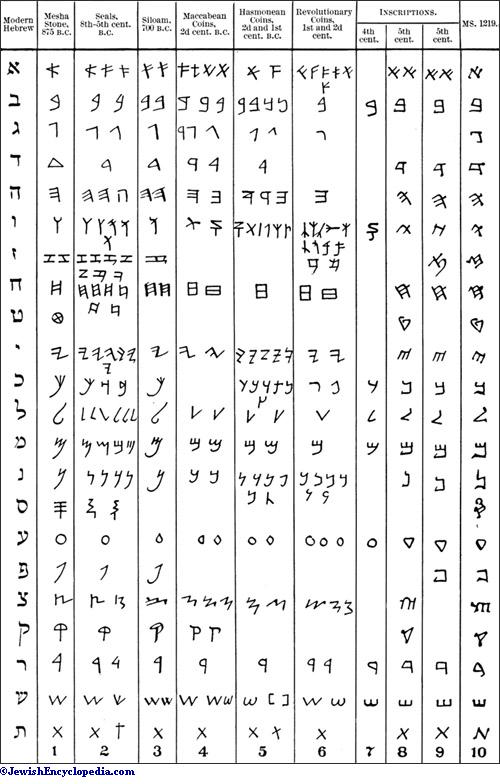
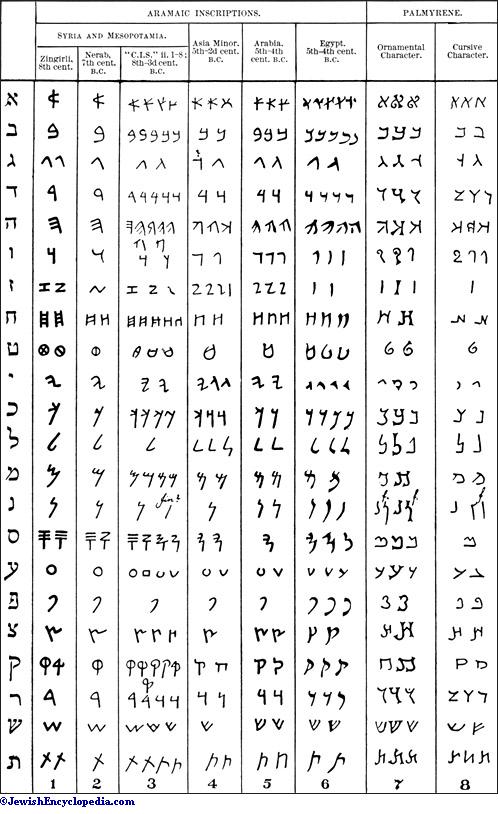
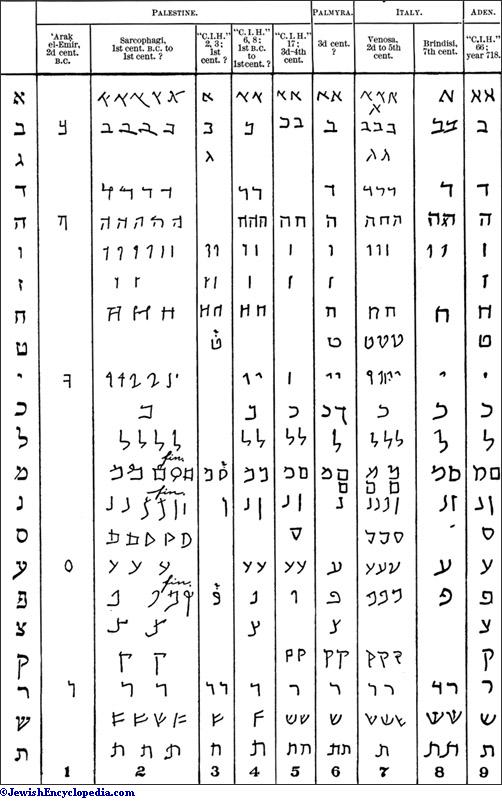
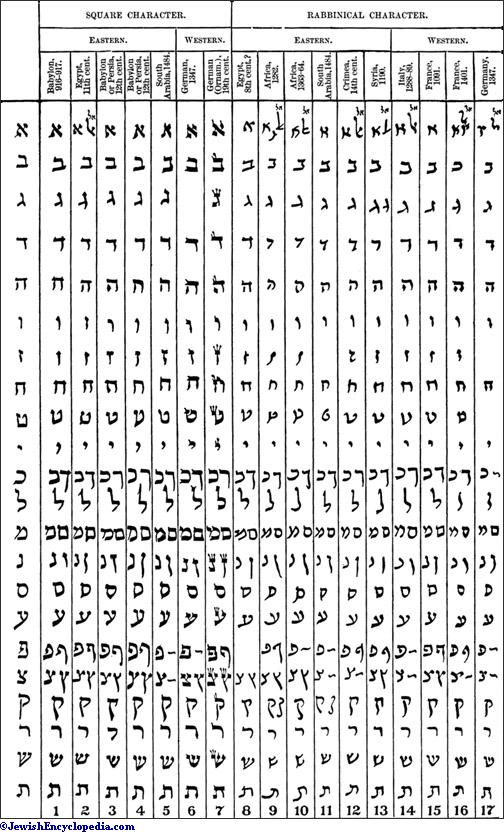
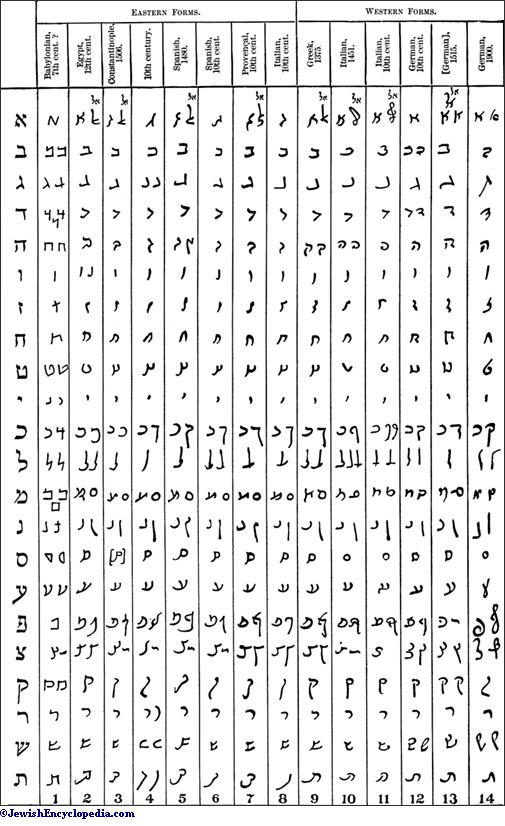
- Gesenius, Geschichte der Hebräischen Sprache und Schrift, pp. 137 et seq., Leipsic, 1815;
- H. Hupfeld, Kritische Beleuchtung Einiger Dunkeln und Missverstandenen Stellen der Alttestamentischen Textgeschichte in Theologische Studien und Kritiken, iii. 259 et seq.;
- Marquis de Vogüé, L'Alphabet Hébraïque et l'Alphabet Araméen, in Revue Archéologique, new series, xi. 319 et seq.;
- Fr. Lenormant, Essai sur la Propagation de l'Alphabet Phénicien, i. 173 et seq., 259 et seq., Paris, 1875;
- Ad. Neubauer, The Introduction of the Square Characters in Biblical Manuscripts, in Studia Biblica, iii. 1 et seq.;
- Ph. Berger, Histoire de l'Écriture dans l'Antiquité, 2d ed., pp. 188 et seq., Paris, 1892;
- M. Lidzbarski, Handbuch, i. 183 et seq., 189 et seq.;
- Leop. Löw, Graphische Requisiten und Erzeugnisse bei den Juden, ii. 38 et seq., Leipsic, 1871;
- M. Steinschneider, Vorlesungen über die Kunde Hebräischer Handschriften, pp.27 et seq., Leipsic, 1897;
- De Wette-Schrader, Lehrbuch der Historisch-Kritischen Einleitung in das Alte Testament, 8th ed., pp. 185 et seq., Leipsic, 1869;
- B. Stade, Lehrbuch der Hebräischen Grammatik, i. 22 et seq., Leipsic, 1879;
- Bleek and Wellhausen, Einleitung in das Alte Testament, 5th ed., pp. 580 et seq., Berlin, 1886;
- C. Schlottmann, Schrift und Schriftzeichen in Riehm's Handwörterbuch des Biblischen Altertums, 2d ed., pp. 1416 et seq.;
- H. L. Strack, Schreibkunst und Schrift bei den Hebräern in Real-Encyklopädie für Protestantische Theologie, 2d ed., xiii. 690 et seq.
- Facsimiles of Hebrew manuscripts may be found in the following works: Chwolson, C. I. H. 1881 et seq., in Oriental Series of the Publications of the Paleographical Society, London, 1875-83;
- Steinschneider, Catalogues of the Hebrew Manuscripts of the Libraries of Leyden (1858), Munich (1875), and Berlin, i. (1878);
- Neubauer, Cat. Bodl. Hebr. MSS. (facsimiles);
- B. Stade, Gesch. des Volkes Israel, i. Berlin, 1887.
- For a complete bibliography see M. Steinschneider in Centralblatt für Bibliothekswesen, iv. 155 et seq. For tables of alphabets see Publications of the Paleographical Society, lxxxvii. (Euting);
- Bickell and Curtiss, Outlines of Hebrew Grammar, Leipsic, 1877;
- Euting, in Corpus Inscriptionum Hebraicarum;
- Neubauer, The Introduction of the Square Characters (Brünnow).
1. Mesha Stone. 2. Seals and Gems; see Bibliography and Lidzbarski, Handbuch, Plates iii. 1, xlvi. 3. Siloam Inscription. 4-6. Coins, according to Madden. 7. Inscription from 'Amudas. 8-9. Inscriptions from the fifth century; compare Lidzbarski, Handbuch, i. 440; and Berger, Histoire de l'Écriture, 2d ed., pp. 200 et seq. 10. Samaritan-Pentateuch Manuscript of the year 1219, Hebrew and Arabic, according to the Oriental series, vol. xxviii. in the Publications of the Paleographical Society.
Plate II. (Origin and Development of the Hebrew Square Alphabet.)1. Inscriptions of Zenjirli. 2. Inscriptions of Nerab. 3. Inscriptions on weights and clay tablets. 4. Inscriptions from Asia Minor; compare Lidzbarski, Handbuch, i. 446; and Ephemeris, i. 59 et seq. 5. Inscriptions from Arabia; see C. I. S. ii. 113-115. 6. Inscriptions and papyri from Egypt, C. I. S. ii. 122 et seq. 7-8. Palmyrene inscriptions; compare Lidzbarski, Handbuch, ii., plate xxvii. et seq.
Plate III. (Ancient Hebrew Inscriptions.)1. Inscription from 'Araḳ-el-Emir. 2. Inscriptions on ossuaries, according to C. I. H. plate iv. 193. 3. C. I. H. 2 (Gezer) and 3. 4. C. I. H. 6 (Bene Ḥezir) and 8 (Gaza). 5. 17 (Kefr Biraim). 6. Inscriptions from Palmyra. 7. Inscriptions on the Catacombs of Venosa. 8. Tumulary inscriptions from Brindisi, seventh century. 9. Tumulary inscriptions from Aden, 66.
Plate IV. (Manuscript Writing.)1. Babylonian Codex of the Prophets in St. Petersburg. 2. Manuscript of Sirach. 3. Pentateuch with Targum from Babylonia or Persia, twelfth century, British Museum, Oriental, 1467. (According to Paleographical Society, Oriental series liv.) 4. Manuscript of the Prophets, from Persia, Babylonia, or Southern Arabia, twelfth century, British Museum, Harl. MS. 5720 (Paleographical Society, Oriental series xl.). 5. Hafṭarot with the Targum Jonathan from Southern Arabia from the year 1484. 6. Hagiographa with Rashi. German (Ashkenazi), of the year 1347. Cambridge University Library, Ee 5, 9 (Paleographical Society, Oriental series xli.). 7. Modern German script of the nineteenth century with ornamental flourishes or strokes. 8. Papyri from Egypt. 9. MS. alphabet of the TaḦamonim (African Sephardic) of 1282. British Museum, Additional Manuser, of 27113 (Paleographical Society, Oriental series lv.). 10. Sefer ha-Mishḳol written at Mustaghanem (Algeria), in 1363-64. Cambridge University Libr., Cod. 11. 22 (Paleographical Society, Oriental series xxx.). 11. See 5. 12. Epigraph from a Karaite Pentateuch roll from Theodosia (Crimea), about 1325 (C. I. H. 138). 13. Rashi on Baba Meẓi'a, written probably at Mosul (betraying the influence of a Greek-Ashkenazi hand) in 1190. British Museum, Oriental, 73. (According to Paleographical Society series xv.). 14. Talmud Yerushalmi, written at Rome in 1288-89 (Italian-Ashkenazi hand). Leyden University Library. Cod. Hebr. Sealiger 3. (Paleographical Society, Oriental series lvi.) 15. Menahem, MaḦberot, probably written in France in 1091 (French-Ashkenazi type). British Museum, Additional Manuser. of 27214. (According to the Paleographical Society, Oriental series xiii.) 16. Semak, copied by R. Moses of Zurich (French-Ashkenazi), in 1401. Cambridge University Library, Additional Manuser. No. 560 (Paleographical Society, Oriental series lxviii.). 17. See 6.
Plate V. (Cursive Writing.)1. Incantation upon Babylonian dish, in C. I. H. 18. 2. Egyptian of the twelfth century. 3. Constantinople, 1506. 4. Tenth century. 5. Spanish, date 1480. 6. Spanish, tenth century. 7. Provençal, tenth century. 8. Italian, tenth century. 9. Greek, dated 1375. 10. Italian, dated 1451. 11. Italian, tenth century. 12. German, tenth century. 13. Eleazer of Worms,  , copied at Rome in 1515 by Elias Levita, German-Ashkenazic, British Museum, Additional Manuser. of 27199 (Paleographical Society, Oriental series lxxix.). 14. Ashkenazic from the nineteenth century.
, copied at Rome in 1515 by Elias Levita, German-Ashkenazic, British Museum, Additional Manuser. of 27199 (Paleographical Society, Oriental series lxxix.). 14. Ashkenazic from the nineteenth century.















